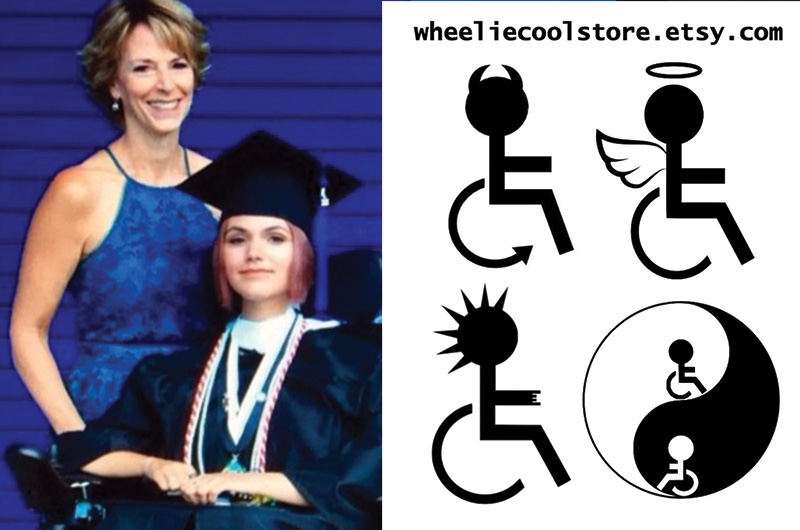Minimally invasive approaches help ease Sydney’s chronic pain

Sydney Hart wants to reimagine the traditional “handicap” symbol. In her online shop, she offers pins, stickers, and other products that infuse the classic wheelchair silhouette with yin-yang symbols, LGBTQ and transgender flags, and even sassy devil horns. “I hope that having symbols with more character will open up the conversation and humanize people with disabilities,” she says. “I want everyone to realize that we are real people with personalities.”
Sydney herself has used a wheelchair herself since she was 9 years old. An extremely active child who loved dancing ballet and playing lacrosse, she first came to Boston Children’s Hospital when she started having trouble staying on her feet. In the beginning, clinicians couldn’t determine why she kept falling down. Eventually, she was diagnosed with a rare form of muscular dystrophy. This progressive condition causes muscle weakness that worsens over time and can eventually cause the inability to walk. Some forms can also affect the lungs.

No slowing down
Now 23, Sydney hasn’t let the diagnosis slow her down. Last year, she graduated from Florida’s Eckerd College with two undergraduate degrees in psychology and music management, with a minor in Japanese. Because muscular dystrophy has weakened her arms, her mother accompanied her to college, acting as a scribe, driver, and assistant throughout the four years. Sydney now works for the school.
Despite temporarily living in Florida, the pair have traveled back to Boston Children’s for Sydney’s care. In addition to seeing Dr. Basil Darras, director of the hospital’s Neuromuscular Center and Dr. Charles Berde in the hospital’s Chronic Pain Clinic, Sydney has regular appointments in the Division of Pulmonary Medicine to address related respiratory concerns. But her most frequent visits are with Dr. Pradeep Dinakar, director of the Pediatric Interventional Pain Program.

Minimally invasive pain relief
Like others with muscular dystrophy, Sydney experiences chronic pain, mainly in her spine. “It’s based very much on my position,” she explains. “When I lie down, that triggers pain.” After other forms of conventional pain relief failed, Dr. Dinakar recommended a minimally invasive technique called water-cooled radiofrequency ablation. This approach uses heat from an electrical current produced by radio waves to safely deactivate the nerves that transmit pain.
Although water-cooled radiofrequency ablation is typically used in adults, Dr. Dinakar has modified it for special use in teens and young adults with refractory and debilitating pain. He performed this advanced procedure in collaboration with Brigham and Women’s Hospital and Massachusetts General Hospital.
The procedure provides about four months of significant pain relief until Sydney’s nerves fully regenerate, and she returns to Boston for regular treatments. The experience is made easier by the personalized touches that Dr. Dinakar and his team add. “They know that I’m most comfortable in my wheelchair, so they put me under sedation when I’m still in my chair and then do procedure and put back me back in chair before I wake up,” says Sydney.

A long-term plan
Although she’s had great success with water-cooled radiofrequency ablation, Sydney and her doctors know that the procedure will likely become less effective with time. To that end, Sydney and Dr. Dinakar work closely with Dr. Berde to brainstorm new approaches for better results.
When she’s not hanging out with friends, cuddling her cat, or binge-watching Netflix, Sydney is busy applying to graduate schools, with the ultimate goal of someday getting her PhD in clinical psychology. But she’s not too busy to check in with her care team in Boston. “I trust these doctors with my life,” she says. “I’ll keep coming to Boston for as long as I can.”
Learn about the Pediatric Interventional Pain Program and the Chronic Pain Clinic.
Related Posts :
-

Which pain medication is right for your child? What a pediatrician wants parents to know
There’s no shortage of safe and effective pain medications for children. Acetaminophen (commonly known as Tylenol), ibuprofen (Motrin, Advil), ...
-

When to refer a pediatric patient for endometriosis
Endometriosis is a complex disease in which endometrium-like tissue grows in locations such as the fallopian tubes, ovaries, or pelvic ...
-

‘What I want you to know about endometriosis’: Iva’s story
Growing up, I heard stories about how everyone’s first period is usually no big deal. The cramps, the fatigue, ...
-

Crossing the ocean: Kathryn learns how to manage chronic pain
When Kathryn Chechile, 11, “graduated” from Boston Children’s Pediatric Pain and Rehabilitation Center (PPRC) last year, she painted a tile ...





